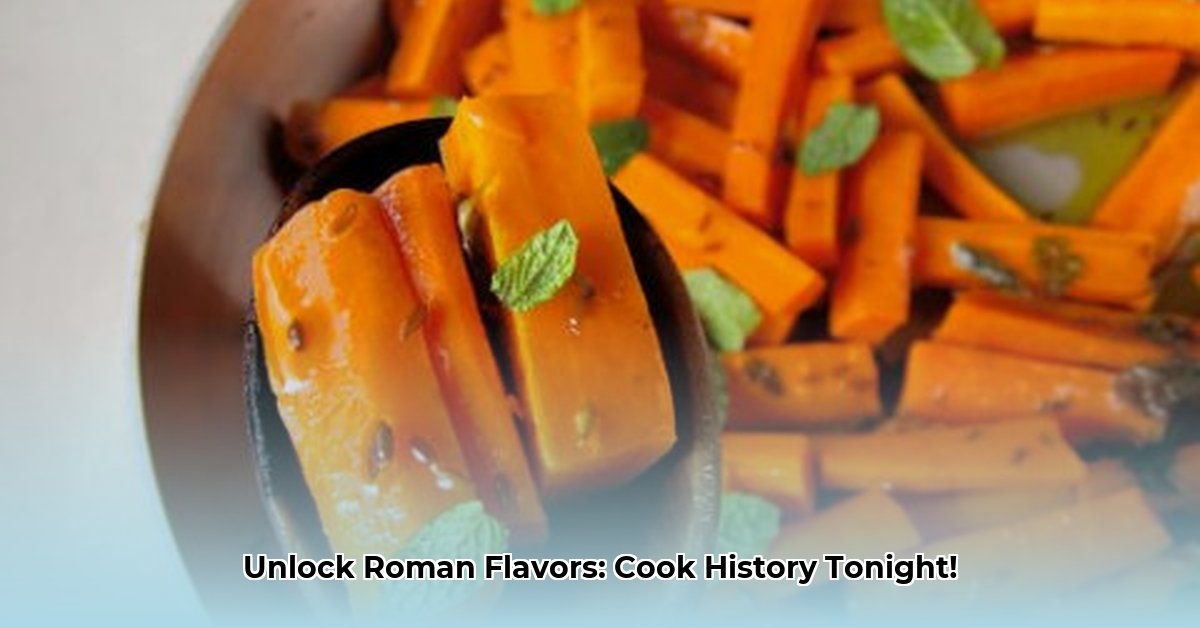Hey, culinary adventurers! Prepare for an extraordinary journey back in time, where you can whip up astonishing dishes from ancient Rome right in your own kitchen. Many might imagine Roman chefs created mundane or uninspired food, but nothing could be further from the truth! We’re about to recreate ancient Roman recipes that are bursting with authentic flavors, adapted for modern accessibility.
Want to explore the topic further? Learn more here for related articles. This comprehensive guide will not only provide you with step-by-step instructions but also delve into the historical significance and unique characteristics of each dish. From Garum, their famed secret weapon sauce, offering a burst of savory depth, to Libum, a delightful Roman cheesecake that perfectly balances sweet and savory notes, and Moretum, a vibrant herb spread ideal for dipping, we’ll explore the diverse Roman spices and culinary philosophies that elevated their cuisine. Beyond these, we’ll dive into hearty staples like Puls porridge, delightful desserts such as Patina de Piris, and even the celebrated Mulsum honeyed wine. So, tie on your apron and let’s begin cooking like the Romans did – no time machine required!
The Foundations of Roman Flavor: Garum, Spices, and Staples
Have you ever found yourself wondering what people in ancient Rome actually ate? Forget the stereotypical Hollywood images of extravagant, endless feasts; Roman cuisine, while certainly capable of opulence, was also remarkably resourceful, adaptable, and deeply flavorful. Fortunately for us, achieving a genuine taste of ancient Roman cuisine is simpler than you might imagine! While sourcing authentic silphium – a key Roman spice that is now tragically extinct – might prove impossible, many other ancient Roman recipes can be readily adapted for our modern kitchens. These adaptations offer a direct, flavorful connection to significant historical periods, grounding your culinary exploration in genuine history. Are you prepared to transport your taste buds across millennia? Let’s embark on this remarkable culinary adventure!
Garum: The Soul of Roman Cuisine
Imagine garum as the ultimate umami enhancer of ancient Rome! This famed fermented fish sauce was the fundamental ingredient that imparted Roman food with its distinctive, profound savory character. Historically, the authentic preparation involved meticulous, months-long fermentation processes, typically using small oily fish like anchovies or mackerel, ample salt, and the consistent warmth of the Mediterranean sun. While detailed methods can be found on various culinary sites, the practical reality is that most modern home cooks don’t have three months to wait for a sauce, nor a dedicated outdoor fermentation setup. Worry not! A high-quality Asian fish sauce, widely available in most grocery stores, serves as a surprisingly effective, albeit not precisely identical, substitute for Roman garum. However, for the truly adventurous, we will outline how to make a simplified version.
Key Takeaways for Garum:
- Garum, a Roman fish sauce, delivers a distinct umami flavor.
- You can achieve this flavor by fermenting fish or using a quicker boiling method.
- Historical recipes used fish innards for a premium version, but whole fish works well.
- Sanitation is crucial during the garum-making process.
- Be mindful of the strong odor during fermentation if choosing that path.
Ready to unlock the intense, savory flavors of ancient Rome? Garum, the umami-rich fish sauce that seasoned nearly every Roman dish, might initially seem daunting to recreate at home. But rest assured! This comprehensive guide will meticulously walk you through how to make garum right in your own kitchen, skillfully adapting ancient techniques for contemporary use. Imagine it as a culinary time machine, effortlessly bringing the authentic tastes once enjoyed by emperors and gladiators directly to your modern table.
Choosing Your Method: Fermentation vs. Boiling
So, which pathway will you ultimately choose for your garum creation? The slow, patiently rewarding road of traditional fermentation, or the quick, more immediate route of boiling?
- Fermentation: This method faithfully mimics the traditional Roman process, relying on natural enzymes within the fish to break down proteins over a period of weeks or even months. The result? A profoundly complex, intensely funky flavor that true garum connoisseurs often crave. It’s ideal for those with patience and outdoor space.
- Boiling: If patience is not among your primary virtues, this method presents a considerably faster alternative. Boiling significantly accelerates the process, yielding a similar, though arguably less nuanced, umami punch in a fraction of the time. This is better suited for indoor preparation and quicker gratification.
Ingredients: The Building Blocks of Umami
Regardless of the chosen method, a few essential core ingredients are absolutely indispensable for crafting authentic garum:
- Fish: Oily fish varieties such as mackerel, sardines, or anchovies are exceptionally ideal. These types of fish reliably provide the necessary proteins and fats crucial for developing that signature, deep garum flavor. Freshness is paramount for both safety and taste.
- Salt: This key ingredient serves more than just a taste function; salt actively inhibits the growth of harmful bacteria and significantly aids in the overall fermentation process. Always use a high-quality, non-iodized sea salt for optimal results, as iodine can interfere with fermentation.
- Water: Essential for the boiling method to create a liquid medium.
Historically, the Romans occasionally incorporated aromatic herbs and various spices into their garum preparations, so feel entirely free to experiment with your own additions! Crushed peppercorns, dried oregano, or even bay leaves are traditional choices.
How To Make Garum: Fermentation Method (for the truly dedicated)
Ingredients:
* 2 lbs (approx. 900g) fresh, high-quality anchovies or small sardines, guts removed but bones can remain
* 1 cup (approx. 250g) coarse sea salt (non-iodized)
* 1 gallon (approx. 3.8 liters) filtered water (optional, can also use natural fish juices)
* Cheesecloth
Instructions:
1. Prepare Fish: Rinse the fish thoroughly and pat them dry. For a less intense flavor, remove the guts.
2. Combine: In a meticulously clean, large, non-reactive container (a wide-mouthed glass jar or food-grade ceramic crock is highly recommended), carefully layer your chosen fish and salt alternately, starting and ending with a layer of salt. A common and effective ratio for salt is typically between 12.5% and 25% of the total weight of the fish. If desired, pour filtered water over the layers until everything is submerged; otherwise, the fish will release its own juices over time.
3. Weigh Down: Gently place a suitable weight (such as a smaller plate with a clean rock or a water-filled bag) directly on top of the fish and salt mixture. This crucial step ensures that the fish remains fully submerged within its own developing juices, preventing spoilage from air exposure.
4. Ferment: Cover the container with a breathable cheesecloth, securely fastening it with twine or a rubber band. This strategic covering permits the escape of fermentation gases while simultaneously preventing any unwanted airborne guests, such as flies, from contaminating your preparation.
5. Wait: Store the covered container in a warm, consistently dark place (ideally around 75-85°F or 24-29°C) for a duration ranging from several weeks to potentially several months (3-6 months is common). Stir the mixture every week with a clean, non-reactive spoon to ensure even fermentation and to help break down the solids.
6. Strain: Once the fish has visibly broken down into a distinctly murky liquid, carefully strain the entire mixture through a fine-mesh sieve lined with several layers of clean cheesecloth into a clean bottle or jar. Press gently on the solids to extract every last drop of that golden goodness. Discard the solids.
7. Store & Enjoy: Store your homemade Garum Fish Sauce in the refrigerator. It will keep for up to a year. Use sparingly, as a few drops add potent umami.
Pro Tip: Effective odor control is absolutely paramount! The fermentation process can release remarkably potent smells, so it is highly advisable to consider fermenting your garum outdoors or within a very well-ventilated area, away from living spaces.
How To Make Garum: The Boiling Method (Quicker Adaptation)
Ingredients:
* 1 cup (approx. 250g) anchovy fillets (packed in oil, drained, or fresh small fish)
* 2 cups water or low-sodium vegetable broth
* 1/4 cup coarse sea salt (non-iodized)
* 1 tablespoon white wine vinegar (optional, for tang)
* 1/2 teaspoon black peppercorns, crushed
* 1 bay leaf
Instructions:
1. Combine: In a clean, medium saucepan, combine your selected fish, water or broth, salt, crushed peppercorns, and bay leaf.
2. Simmer: Gently bring the entire mixture to a consistent simmer over a low-to-medium heat setting. Avoid a rolling boil as it can diminish the delicate flavors.
3. Cook: Allow the mixture to continue simmering for at least 1-2 hours, stirring occasionally, until the fish has completely broken down and the liquid has significantly reduced in volume and appears cloudy with released fats.
4. Strain: Carefully strain the entire mixture through a fine-mesh sieve lined with a clean cheesecloth into a clean bottle or jar. Press down on the solids to extract as much liquid as possible.
5. Reduce (Optional): For an even more concentrated flavor profile, return the strained liquid to the pot and gently simmer until it achieves your desired consistency (it should coat the back of a spoon). Stir in the white wine vinegar during this step if using.
6. Store & Enjoy: Let cool completely before storing in an airtight bottle in the refrigerator. It should last several weeks.
Using Your Garum: A Taste of Ancient Rome
Now that you have successfully created your own garum, it is time to unleash its incredible flavor potential! Employ it as a formidable secret weapon in your sauces, hearty stews, and surprisingly, even in some desserts (a tiny dash can balance sweetness like salt does in chocolate). Just a few drops possess the power to elevate a simple dish to truly unprecedented culinary heights. Consider it the Roman equivalent of modern soy sauce or Worcestershire – a versatile flavor enhancer that imparts remarkable depth and complexity to your cooking. Historical Italian Cooking, for instance, notes: “Garum or liquamen is the ancestor, if not the twin brother, of the current Southeast Asian fish sauces.” This insight confirms you are in excellent company!
Understanding Roman Flavors: Essential Spices, Herbs & Staples
Are you ready to immerse yourself in the wonderfully fragrant world of ancient Roman spices and pantry staples? It’s akin to stepping back in time to a bustling, vibrant market where exotic aromas mingled with the scent of fresh produce. Spices served as more than mere flavor enhancers in ancient Rome; they were vital for Roman health, social status, and even spiritual practices. Apicius, the renowned ancient Roman cookbook (more formally known as De re coquinaria), offers invaluable insights into their sophisticated spice usage, revealing a palate far more complex than many realize.
Romans commonly utilized a wide array of spices and herbs in their daily cuisine, often in combinations that might surprise modern tastes.
Key Roman Spices & Herbs:
- Pepper (Piper): Extremely popular and widely used, black pepper was a luxury item imported from India and was used generously in savory dishes, and even occasionally in desserts to add a sharp counterpoint.
- Cumin (Cuminum): A staple, often roasted and ground, it provided an earthy, warm note to many dishes, from stews to meat preparations.
- Saffron (Crocus): Highly prized for its vibrant color and delicate, slightly sweet aroma. Used in sauces, sweets, and even as a dye.
- Cinnamon (Cinnamomum): Imported from distant lands, it lent a warm, sweet, and somewhat pungent flavor to both sweet and savory dishes, particularly those featuring honey or wine.
- Coriander (Coriandrum): Both the seeds (for a citrusy, nutty flavor) and the fresh leaves (for a bright, pungent note) were widely employed.
- Mint (Mentha): Fresh mint was a common herb, adding coolness and freshness to sauces, spreads, and even meat dishes.
- Rue (Ruta): A bitter, aromatic herb often used sparingly for its strong, distinctive flavor.
- Lovage (Ligusticum): Provided a strong, celery-like flavor, frequently appearing in sauces and meat preparations.
- Asafoetida (Laseris Radix / Silphium substitute): The elusive silphium was a highly prized spice for its oniony, garlicky flavor, but when it became incredibly scarce and eventually extinct, asafoetida was used as a close substitute, providing a similar pungent aroma.
- Bay Leaves (Laurus): Used fresh or dried, bay leaves imparted an aromatic, slightly bitter note to roasted meats, stews, and even certain desserts like Libum.
Common Roman Staples & Ingredients:
- Barley (Hordeum): A fundamental grain, often consumed as porridge (Puls) or in baked goods.
- Lentils (Lens): A common legume, forming the basis of many hearty stews.
- Cheese (Caseus): Fresh, salted, and aged cheeses were integral, especially Pecorino Romano and ricotta-like fresh cheeses.
- Honey (Mel): The primary sweetener, used extensively in drinks, desserts, and even savory dishes.
- Olive Oil (Oleum): The omnipresent fat in Roman cooking, used for cooking, dressing, and preservation.
- Wine (Vinum): Consumed daily, often diluted, and also a key ingredient in cooking (e.g., Mulsum, Defrutum).
- Vinegar (Acetum): Used for tang and preservation, often paired with garum in sauces like oxygarum.
- Figs & Dates: Common fruits, fresh or dried, providing natural sweetness.
These spices and staples frequently served significant medicinal purposes, treating a range of ailments from common colds to complex digestive issues. By understanding these core ingredients, you can truly appreciate the Roman culinary philosophy of balancing flavors, utilizing local bounty, and adapting exotic imports.
Iconic Roman Dishes for Your Table
Now, let’s bring these ancient flavors to life with recipes you can make today. Each recipe is designed to be approachable, using ingredients readily available in modern supermarkets, while retaining the essence of its Roman heritage.
Libum: Roman Ricotta Cheesecake
Do you possess a sweet tooth? Libum, a classic Roman cheesecake, offers a simple yet profoundly satisfying dessert that is sure to captivate any palate. According to various historical recipes, this rustic cake was often served as an offering to household gods. The magnificent outcome? A dense, subtly sweet cake that could effortlessly integrate into your contemporary dessert repertoire. Here’s where the fun truly begins: feel completely free to experiment! Some ancient culinary texts even propose incorporating a bay leaf or two for a distinctly unique aromatic note. How’s that for pushing the boundaries of traditional dessert creation? This ancient Roman delicacy perfectly exemplifies simple ingredients producing complex flavors.
Ingredients:
* 1 cup (approx. 240g) creamy ricotta cheese, whole milk
* 1 large farm-fresh egg, beaten
* 1/2 cup (approx. 60g) all-purpose flour, sifted
* 2 tablespoons golden honey, plus extra for drizzling
* 1/2 teaspoon finely ground bay leaves (optional, but authentic)
* A pinch of sea salt
* 1 tablespoon unsalted butter, for greasing
Instructions:
1. Preheat Oven: Preheat your oven to 375°F (190°C). Generously grease a 9-inch pie pan or an 8-inch round cake pan with unsalted butter, ensuring every nook and cranny is covered for a flawless release.
2. Combine Wet Ingredients: In a large mixing bowl, whisk together the creamy ricotta cheese and beaten egg until the mixture is as smooth as a senator’s speech.
3. Fold in Dry Ingredients: Gently fold in the sifted all-purpose flour, ground bay leaves (if using), and sea salt, mixing just until the dough comes together. Avoid overmixing to maintain a light texture.
4. Shape & Bake: Shape the dough into a round loaf or press it evenly into your prepared pan. For an authentic touch, you can press a whole bay leaf into the top before baking. Bake for 25-30 minutes, or until the cheesecake is golden brown and firm to the touch, like the walls of the Pantheon.
5. Cool & Serve: Remove from the oven and immediately drizzle with extra honey. Let it cool slightly in the pan for 5-10 minutes, allowing flavors to meld, then transfer to a wire rack to cool completely. Serve warm or at room temperature.
Velvety yet rustic, this cheesecake boasts a subtle tang from the ricotta, perfectly balanced by the floral sweetness of honey. Serve it warm with a side of fresh figs or berries for a dessert that’s truly fit for an emperor.
Moretum: The Ultimate Roman Herb and Cheese Spread
In search of a quick and exceptionally flavorful appetizer? Moretum is your definitive answer! This vibrant ancient Roman herb and cheese spread highlights the Roman appreciation for fresh, uncomplicated ingredients. Culinary historians and adapted recipes emphasize the delightful synergy that occurs when Pecorino Romano cheese (a famously salty, hard cheese), fresh garlic, fragrant parsley, cool mint, robust olive oil, a pinch of salt, and a dash of pepper are combined. Simply blend these humble ingredients until a smooth consistency is achieved. The final product is a vivid, bold spread, and it is also incredibly versatile! Utilize it as a delightful dip for crisp vegetables, spread it generously on crusty bread, or even toss it with freshly cooked pasta. Do not shy away from creative improvisation here. Feel free to swap out the herbs to your personal liking. Many contemporary cooks enjoy adding cilantro or even a delicate touch of fennel for an intriguing modern twist
- Unearth ancient rome achievements: Engineering feats & legal legacies, examined - August 13, 2025
- Unlock ancient rome army ranks: Power, impact & legion command - August 13, 2025
- Conquer Your Exam: Ancient Greece Quiz Ace It Now! - August 13, 2025
















